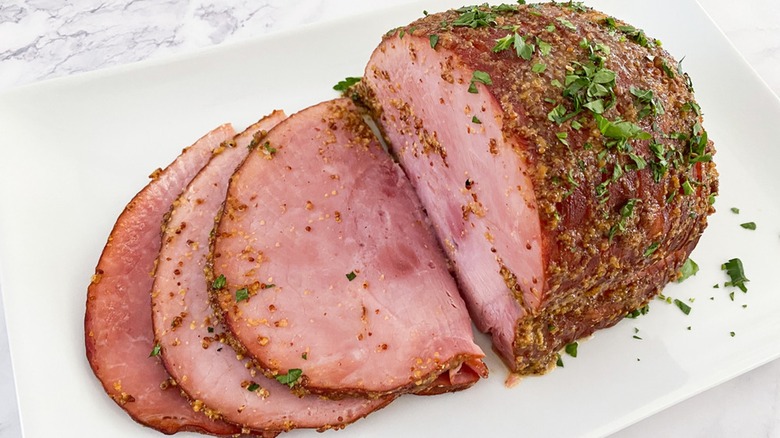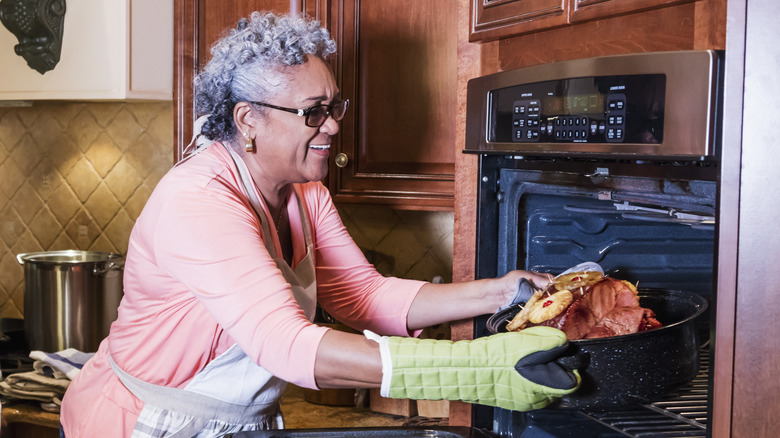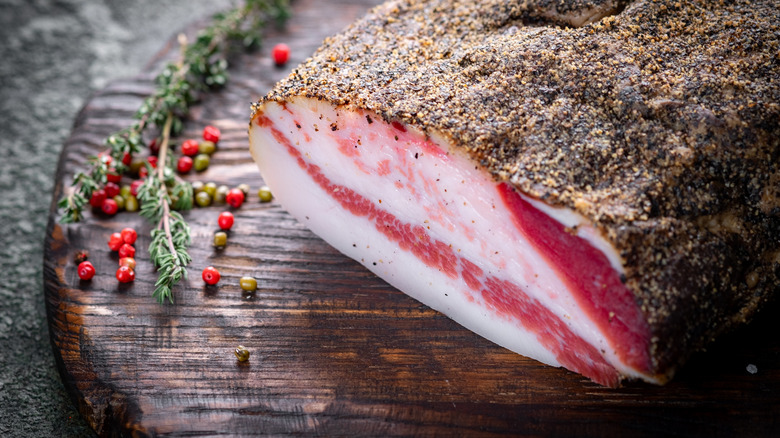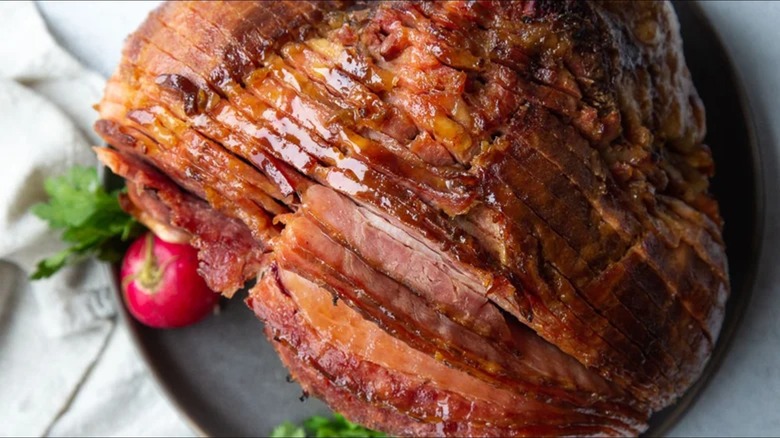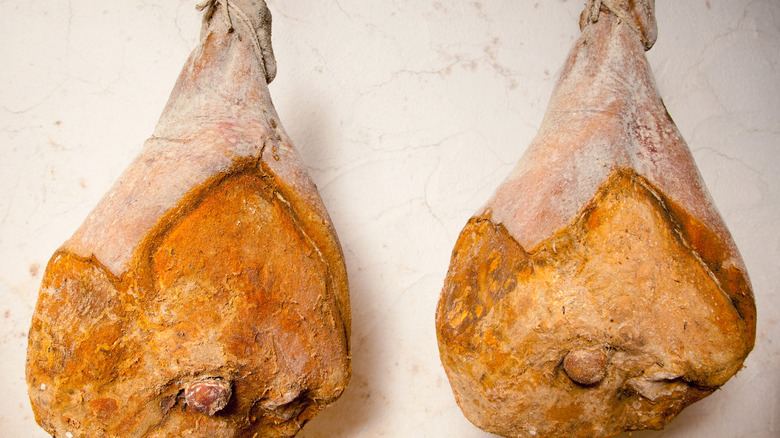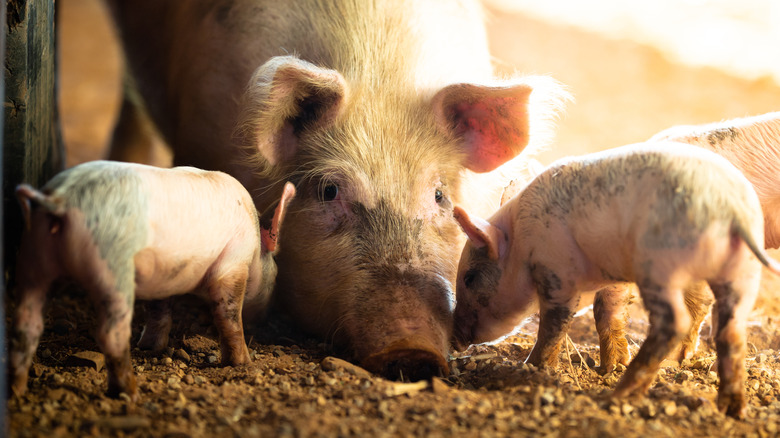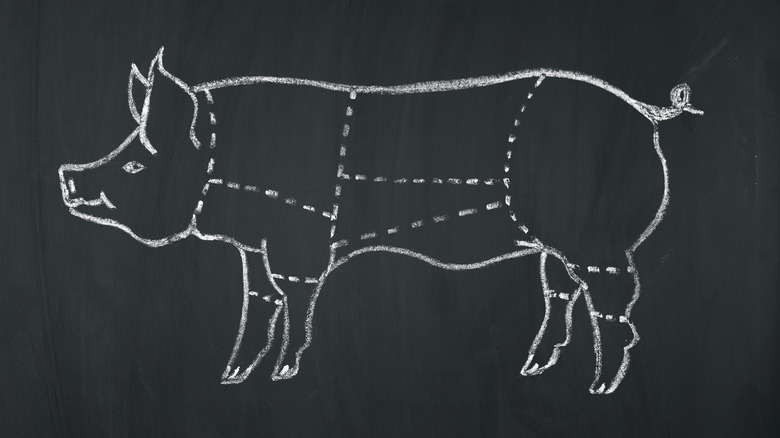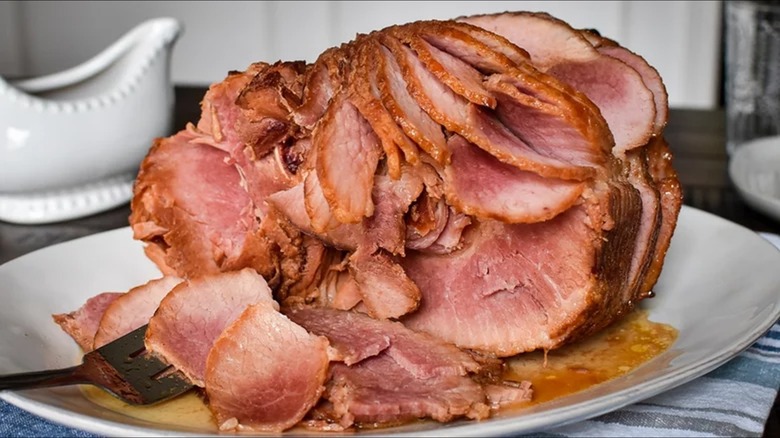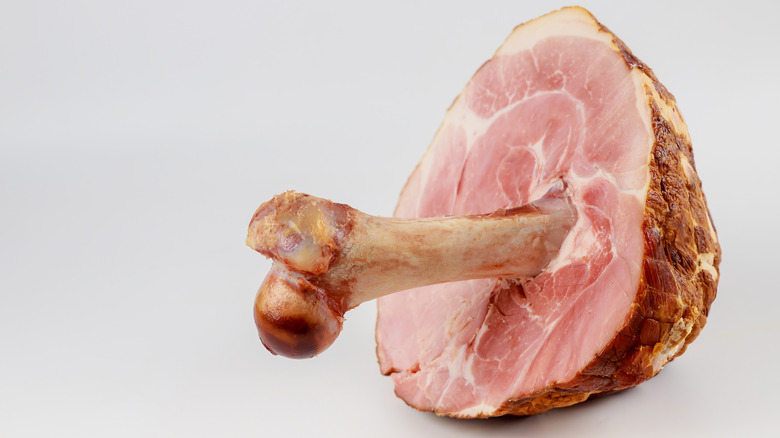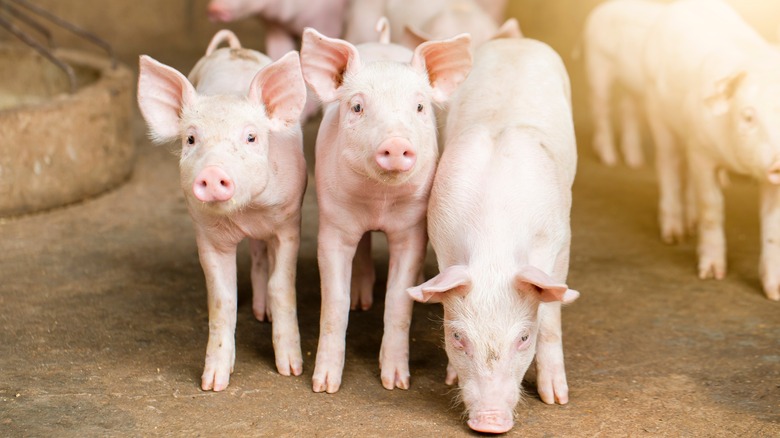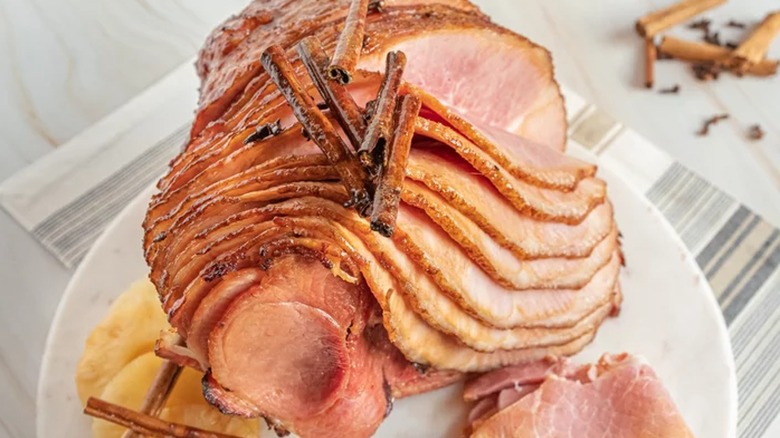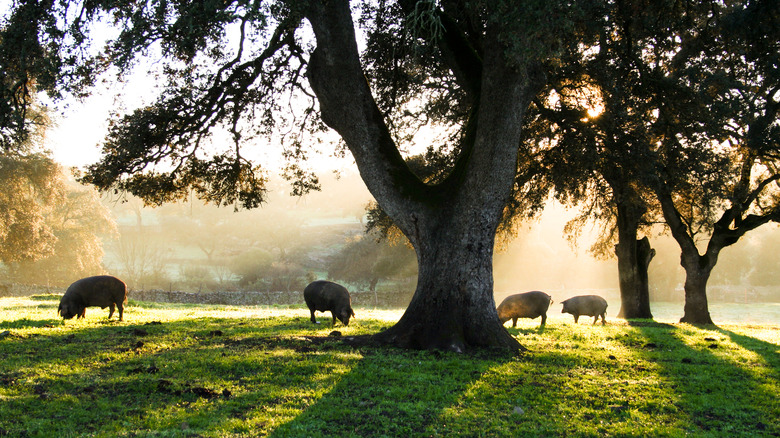False Facts About Ham You Thought Were True
Before you cut into your next ham, it's time to unlearn all the false facts you've been holding onto about it. Whether the myths come from old wives' tales you've heard for years or are false information about nutrition and safety, there are plenty of misconceptions about ham out there that need to be debunked.
There are many types of ham, so some of the information that you think you know may relate to one variety but not apply to all kinds of ham. You also might have been getting rid of ham for safety's sake when it was still fine to eat. While certain types of ham taste better than others, they may not be the ones you think. Plus, you may even be slicing it at the wrong time. Whatever it is that you've been getting wrong about ham, we're here to set it straight for you once and for all.
False: All ham needs to be cooked before serving
Pre-cooked hams you get from the store often come with cooking instructions. Plus, there are plenty of baked ham recipes in existence. However, if you look carefully, these cooking instructions are often really reheating instructions, because the ham doesn't arrive at the store raw.
The USDA explains, "Both whole or half, cooked, vacuum-packaged hams packaged in federally inspected plants and canned hams can be eaten cold, right out of the package." However, once your ham is unwrapped, it has the potential to become contaminated with pathogens from handling or from its environment. So, it's a good idea to heat it after it's been sitting around for a couple of days in the fridge.
If you're reheating ham straight from the package for the first time, getting it to 140 degrees Fahrenheit will be fine for your purposes. However, once it becomes leftovers or has been left sitting out for a significant amount of time, you should heat it to 165 degrees Fahrenheit before serving it again. So, if you're going to use leftover ham in a recipe, you need to ensure it gets hot enough.
False: All ham has to be refrigerated
When most of us think of meat, we instantly assume it needs refrigeration. However, not all hams need refrigeration to be safe. Of course, ham lunch meat requires refrigeration, but certain types don't.
Dry-cured ham, prosciutto (the Italian version of dry-cured ham), and country ham are among the types of ham that are safe to store without refrigeration until you cut them. Country hams are both salted and smoked to cure them, while dry-cured hams are preserved with salt and by drying. Even though dry-cured hams start their curing process at low temperatures, the final steps are at high temperatures, so refrigeration isn't necessary.
As long as they haven't been cut yet, the USDA says, these types of ham "can be stored safely at room temperature for up to one year. After one year, the ham is safe but the quality may suffer."
False: Ham is higher in bad fat than other meat
Most of us assume that all the fat you find in meat is the same, but it's not true. It's also not true that ham has more bad fat than other meats. So, you can eat ham without worrying about fat as much as you thought you should.
The type of fat you're eating matters quite a bit when trying to gauge its health effects. Saturated fat is the type that is more nutritionally concerning. The good news is that, while pork has saturated fat, it has less saturated fat than other common red meats like beef and lamb. Some (but not all) health professionals suggest limiting saturated fat to decrease your risk for heart disease. Ham also has more healthy fats – monounsaturated and polyunsaturated fats — which have some potential health benefits. Thus, choosing ham instead of other red meats as part of a healthy diet could be a better choice in terms of limiting saturated fat. However, it's still a good idea to eat it in moderation even if it isn't as fatty as you thought.
False: Since it's regulated, ham is safe for everyone
While it's true that hams in the U.S. must be processed in a way that kills trichinella spiralis parasites, that doesn't mean that ham comes worry-free. Some potential ham pathogens and health considerations may affect certain groups of people more strongly than others. So, it's important to know what risks ham carries.
Two potential pathogens that can make it important to reheat ham are listeria and staphylococcus. Deli meats like ham are susceptible to contamination by listeria, which can be more of a health concern for some categories of people like young children, elderly adults, and pregnant adults. While salt and sugar deter a lot of pathogens in ham, staphylococcus thrives in it. Ham is the top food cause of staphylococcal food poisoning. It doesn't always die at ham cooking temperatures and multiplies when ham is kept between 45 and 118 degrees Fahrenheit.
There are multiple reasons to avoid giving ham to children. Many health groups suggest not giving deli meat ham to children because of added nitrates and their link to cancer. Another reason the CDC mentions for not giving processed meats like ham to children is their high salt content.
False: You should throw out moldy ham
While salt helps inhibit bacterial growth on foods like ham by drying it out, mold can still grow under dry conditions that kill bacteria. So, while salt and other preservatives are busy stopping bacterial growth, mold might still be able to take hold and grow on the surface of your ham. You shouldn't eat the mold, but the mold won't ruin your ham.
Interestingly enough, many ham producers rely on mold to contribute to the distinctive flavor of their meat. These molds tend to proliferate during the curing process in hot summer weather. A Kentucky ham maker who has been making Virginia hams for multiple generations told Chow Magazine, "[E]very ham house has its own mold. So when it gets so hot in the summer and I think I just can't stand it one more minute, I say to myself, 'Nancy, the hotter the summer, the better the ham.'" (via Newsome Country Ham).
While mold might give it extra flavor, you're not supposed to eat the mold. The USDA says to "wash it with hot water and scrub off the mold with a stiff vegetable brush." Some ham producers suggest also washing it in a solution of water and vinegar and soaking the ham in cold water overnight.
False: Ham tastes better from a female pig
One myth you might hear about ham is that female ham has a better flavor than male ham. There's some reasoning behind this myth, but it doesn't stand up to reality in most cases.
There is one unusual case where female pigs taste better, so the myth is partially true. You can occasionally find ham called "sow's ham" for sale. This ham is larger because it comes from pigs who were used for breeding and are allowed to grow bigger since they live longer. When you're comparing sow's ham to uncastrated male ham, sow's ham smells less musky and lacks the urine-like flavor that some people can detect in male pig meat. However, in the modern pork market, male pigs are castrated to eliminate those unpleasant tastes and smells.
When it comes to comparing castrated male ham (the type you will actually find at a grocery store) and female ham, there are some differences. After castration, male pigs eat more than females, and their bodies process more of their food into fat. Just like fattier steak is more tender and juicy, ham with more fat is juicier. Of course, sometimes, you'll find fattier ham from female pigs, too. So, the real trick is to look for fattier ham rather than looking for the gender of the ham.
False: All types of ham come from the same part of the pig
Many people think of ham as coming from the rear part of the pig, but not all hams come from this area. What hams are called relates to which part of the pig they came from. A whole ham comes from the rear, above the legs. If it comes from the upper part of the rear (the butt end), it's more fatty than if it's from the area nearer the legs (the shank end). However, if the ham comes from the area above the front legs (the shoulder area), it's called picnic ham. Picnic ham isn't technically ham since it's really just pork shoulder cured like a ham. However, it still gets the ham name since the flavor and appearance after curing is ham-like. Ham hocks come from the top part of a pig's back legs that correspond to what we would think of as the pig's ankle. Because it has a lot of bone and tendons and not as much meat as other areas, it's more commonly used as flavoring in a pot of greens or soup.
Some other products you might see are ham steaks or breakfast hams. Both are simply thick slices of whole ham. Breakfast ham comes from the center of the ham where it's more tender. If you find something called "boneless ham" (as opposed to "bone-removed ham"), it's processed and could come from any part of the pig.
False: Uncured ham doesn't contain preservatives
If you're looking for a healthier type of ham, you may have run across uncured ham and assumed it didn't have any preservatives. However, despite its name, uncured ham both has preservatives and is cured. We'll explain.
Uncured ham may be healthier than cured ham. While it is cured, it's not cured using chemical brines, synthetic nitrates, and artificial flavorings. Instead, it's cured with more natural preservatives: salt, sugar, acid, and natural curing solutions derived from celery or beets. The vegetable-derived curing solutions prevent the formation of nitrosamines, the cancer-causing chemicals found in traditional cured meats.
If you're looking for it at the grocery store, you may be able to spot it visually because it's not the same color as other hams since it's free of synthetic nitrates. In fact, for marketing purposes, you may find it labeled as "sodium-nitrate-free ham" rather than or in addition to being labeled as "uncured ham."
False: You can give your leftover ham bone to your dog
When your dog has been a good boy or girl, it's tempting to give them your leftover ham bone as a reward. Unfortunately, it's a reward that could turn deadly.
There are several reasons that ham bones aren't good for your dog. The first is related to the ham itself. Giving your dog a small taste is fine, but all the salt and preservatives in ham are bad for them. If you leave a lot of fat on the ham bone, it can upset your dog's stomach in the best-case scenario or cause pancreatitis in the worst-case scenario. The bone is especially bad since it can break teeth or cause a dog to choke to death if it blocks its airway on the way down. Even if the dog chews the bone well, the bone splinters can puncture areas of the digestive system as they work their way through.
Instead of giving your ham bone to your dog, save it either in the fridge or freezer to add flavor to other dishes. All the leftover meat on the bone and the flavors from the marrow are excellent additions to soup, greens, or even red beans and rice. Simply toss it in while cooking and let the ham bone do its magic. You could even use it to make ham stock in the same way you use chicken bones to make chicken stock.
False: Ham from the left leg is better than ham from the right leg
There's an interesting myth out there claiming that left-leg ham is more enjoyable than right-leg ham. There are several ideas behind this myth, but all relate to the pig preferring one leg over the other. One theory says that, when pigs lounge around, they're more likely to rest all their weight on their right leg. In this imagined scenario, the hypothesis was that the left leg (the one it doesn't rest on) would be fattier and tastier. In another hypothetical scenario, the supposition was that a pig's left leg would be more tender because pigs use their right leg for scratching themselves. Both are probably not true.
A study in Laterality looking at whether pigs have a preference for one side of their bodies over the other showed that they don't tend to be left- or right-footed – at least in the tasks the researchers studied. However, they do tend to have a side preference when nosing around with their snout or curling their tails. So, the idea that pigs have a leg preference for certain tasks like laying or scratching probably isn't true. Honestly, if leg preference did affect ham flavor, you'd probably see right-leg hams and left-leg hams at the store and have to pay more for one than the other.
False: Pre-slicing ham doesn't affect it
Whether you buy your ham whole or pre-sliced matters more than you think. There's a reason that a lot of delis store their hams whole and slice them for you (besides being able to give a choice of thickness). While it might be easier to buy a large ham pre-sliced rather than slice it after you buy it, you'll end up with a tastier ham if you acquiesce to slicing it yourself.
Exposure to oxygen makes ham less flavorful and delicious. Sliced ham has more surface area, so this flavor loss from oxygen will happen more quickly, while a whole ham will retain its flavor for longer.
Something else that happens to sliced ham is discoloration. A Meat Science study found the less oxygen that touches the ham and the less light it's exposed to, the better the color of the ham, especially over time.
False: Ham has the same flavor and nutrition whether the pig is free-range or not
A lot of people seek out free-range meat for ethical and health purposes. But does being free-range affect both ham nutrition and flavor? It turns out that it affects both in positive ways.
Many people think that free-range pigs taste better than confined pigs, and this supposition is empirically true. A study in the Asian-Australasian Journal of Animal Sciences that used both human and electronic flavor testing found that pigs that had been raised outdoors tended to taste better than confined ones.
Not only does being free-range affect ham flavor, but it also affects ham nutrition. Various studies show that when they're able to graze in a pasture and root around for food rather than eating solely corn and soy, pigs have a diet higher in Omega-3 fatty acids without as much inflammatory Omega-6 (via Practical Farmers of Iowa). Meanwhile, a study in PLoS One shows that free-range pigs who are about to be out in the sunshine have more Vitamin D in their meat. According to HamStand, Iberico ham pigs that eat a diet of acorns are also rich in Vitamins E, B1, and B12.
False: All ham remains safe in the fridge for the same amount of time
It's false that ham will stay safe in the fridge for the same amount of time no matter which type of ham it is. According to the USDA, while some hams are only good for three to five days in the fridge, others are good for months.
The amount of time you can leave ham in the fridge is about food safety rather than quality. The ones that stay good the shortest are opened shelf-stable canned ham or cooked uncured ham, which are good for only three to four days. The following types of ham are good from three to five days: uncooked and uncured, opened lunch meat, store-sliced lunch meat, or cooked ham that's been vacuum sealed, sliced and store-wrapped, or spiral cut. Ham is good for a whole week after opening if it's store-wrapped and cooked, cooked country ham, or canned ham that's labeled "keep refrigerated."
Dry-cured hams and country hams that are processed in more traditional ways last even longer after cutting. Cut ham is good for two to three months if it's dry prosciutto, parma, or serrano. Uncooked but cut country ham is also good for two to three months in the fridge.
